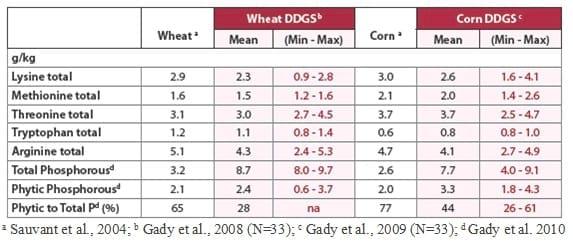Variability of DDGS with NIR
Overcome the variability of DDGS with NIR
Published: January 26, 2012
By: Cecile Gady, Research Manager Feedstuffs & NIR at CERN, Adisseo, France
DDGS can be used in poultry and swine feeds, provided that its quality meets nutritionist's expectations. As an industrial by-product from the ethanol industry, its composition may vary not only among suppliers but also in the course of time, depending on the cereals coming in and technological management of the plant. Therefore, we strongly recommend controlling DDGS quality as frequently as possible. NIR (Near Infrared Reflectance) offers the possibility to check each delivery. Adisseo has been expanding its research by numerous in vivo evaluations of DDGS collected through research centres in the US and through importing countries as well. To date, the database contains about one hundred corn and wheat DDGS evaluated for their amino acids digestibility through in vivo tests. Although there are high-protein containing and standard corn DDGS, the standard class itself already exhibits from 13% to 23% variations among the concentrations in total amino acids whereas lysine digestibility coefficients ranged from 45% to 81%. With Lysine being highly sensitive to heat damage, its digestibility is one of the main issues in the assessment of the quality of DDGS. Adisseo has used its DDGS database to support the development of prediction models using NIR. While concentrations in digestible lysine cannot be efficiently extrapolated from the crude protein content, they can be predicted from NIR modelling (R2 = 0.88) within 6-7% accuracy. Also, as part of its NIR service, Adisseo recently developed NIRS equations to predict total and phytic phosphorus in raw materials which are in the process of being validated for corn DDGS and wheat DDGS. DDGS are known to have, in general, quite high digestible phosphorus contents, (due to both high total phosphorus content and high digestibility). The proportion of phosphorus linked to inositol (phytic phosphorus) for DDGS is half of that of wheat or corn, but this average masks a remarkable variability, probably depending on whether some phytases and processing conditions are used during the production of ethanol. It is therefore advisable to check phytic phosphorus contents of the DDGS used in your feed mill, in order to estimate properly its digestibility and the potential action of your own phytase supplementation.

Related topics
Authors:
Join to be able to comment.
Once you join Engormix, you will be able to participate in all content and forums.
* Required information
Would you like to discuss another topic? Create a new post to engage with experts in the community.
Create a post






.jpg&w=3840&q=75)